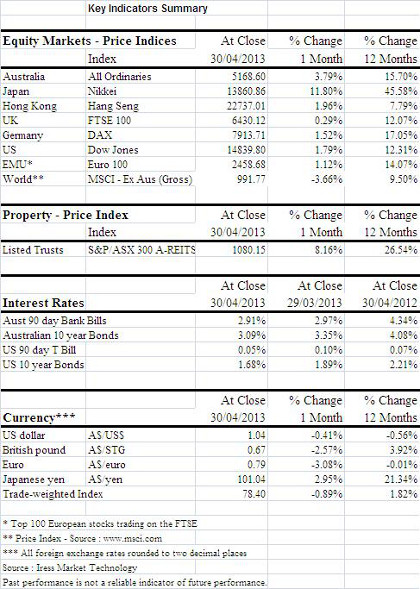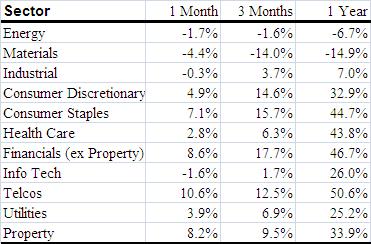ThreeSixty Research Market Update - May 2013
APRIL MARKET PERFORMANCE (table)

 Global economies
Global economies
Last month global economic data on world trade and industrial output produced relatively underwhelming results. However, they were an improvement on the virtually idle results seen throughout much of 2012.
While business surveys in the advanced economies showed a lift in sentiment over future output, emerging markets still remained a key contributor to global growth.
US Economy
In the US, Gross Domestic Product (GDP) results for the March quarter grew by 0.6%. This result was much stronger than the growth seen in the December quarter and reflected a pick-up in consumer consumption, as well as a faster rate of inventory accumulation.
Consumer consumption grew at its fastest pace in over two years, despite the tax increases that came into effect at the start of the year. This was a result of the pick-up in services consumption - which recorded its fastest growth rate since 2005.
The US housing sector continues to be a stand-out, growing by 3.0% in the March quarter to be 13% higher than this time last year. And while the level of activity still remains very low by historical standards, it’s still one of the most rapidly growing sectors.
In the March quarter US inflation remained soft, with core inflation results only slightly increasing, recording an annual rate of 1.3%.
Over to employment and the labour market continues to recover slowly, regardless of a weak March employment report. The unemployment rate fell again, this time by 0.1% to 7.6%, however these results largely reflected a fall in the participation rate.
US net exports recorded their largest decline since the December quarter in 2011. However, imports recovered strongly last month, rising 1.3%, their fastest quarterly growth rate in two and half years.
Europe
Over to Europe and the ongoing issues in Cyprus eroded market confidence in late March, and the decision to “bail-in” depositors has only added to the sentiment.
In response to the uncertainty in Europe, the European Central Bank (ECB) kept monetary policy unchanged in April. Preliminary inflationary data from the Eurozone forecast annual inflation to be 1.2% in April, down from 1.7% in March.
Unemployment in the Eurozone area continued to increase in March, as the seasonally-adjusted figures showed the unemployment rate at 12.1%, up from 12.0% in February. Compared with a year ago, the unemployment rate has increased in 19 member states and fallen in eight.
Another potential area of concern for the Eurozone is the decrease in business investment seen in the fourth quarter of 2012, with the business investment rate recorded at 19.7%. This result was compared to 20% in the third quarter of 2012.
The February trade estimates for the Eurozone area in comparison with the rest of the world, gave a €10.4 billion surplus, compared with the €1.3 billion surplus in February 2012.
China
The Chinese economy grew 1.6% in the March quarter, which was a 7.7% increase on the same period last year. This result is softer than the 8% expected and casts some doubt over expectations for a robust recovery in the first half of the year. Official data showed that growth over the last 12 months was primarily driven by consumption (contributing 4.3%) followed by investment (2.3%).
Over to consumer consumption and retail sales growth picked up slightly in March, but remained relatively subdued at 12.6% over the year.
Chinese industrial production eased further in March, dipping below 9% for the first time since last August. This is in contrast to the timelier manufacturing Purchasing Managers Index (PMI) which recorded marginal improvements in the month. The official PMI rose to 50.9 in March (up from 50.1), driven by a pick up in production. Net exports also made their first meaningful contribution to the economy in three quarters.
On a more positive note, inflationary pressures have so far been kept within acceptable levels, meaning that authorities may have more scope to further stimulate the economy in the second half of the year if necessary. Year-ending consumer price index growth eased to 2.1% in March (from 3.2% in February), helping to allay concerns that authorities would need to tighten economic policies sooner rather than later. Lower inflation was driven mostly by an easing in food costs – following the traditional spike during Lunar New Year – although non-food inflation also eased slightly.
Asian region
Monetary policy has continued to dominate headlines in Japan, following the decision by the Bank of Japan (BoJ) in early April to dramatically loosen monetary policy. The BoJ said it would expand its balance sheet by purchasing longer-term debt and more exotic securities like exchange traded funds. The new purchases - made at an annual pace of ¥60-70 trillion - will double the BoJ's monetary base over a two-year period.
The purpose of the stimulus is to drive up annual inflation to a target of 2%. The need for the stimulus was further highlighted by the 0.5% fall in Japan's consumer price index in March.
Australia
With all eyes on the May Federal Budget, and any changes to fiscal policy prior to the September election, attention has momentarily diverted to monetary policy following the release of the March quarter consumer price index.
Against expectations of a 0.6% rise for the March quarter, the consumer price index only rose 0.4% for an annual pace of 2.5%. This is well within the Reserve Bank of Australia’s (RBA) target range of 2-3% for annual inflation, which provided room for the RBA to cut the cash rate by 0.25% to 2.75% at its May meeting.
Meanwhile, domestic unemployment rose to 5.6% in March, from 5.4% in February, reversing the surprise surge in employment numbers in February. This rate is the highest level recorded in more than three years.
Business confidence improved significantly in the March quarter, and produced the first quarterly rise in sentiment since December 2011 - however confidence still remains below long-run average levels. Much of the improvement in confidence reflects the lessening concerns surrounding a number of external risks, including the US fiscal cliff, a hard landing in China and the reduced risk of a further European crisis.
Business conditions are still clearly signalling below trend growth, as the NAB quarterly business survey returned a domestic demand growth of 2¼% in the March quarter. Of more concern, forward indicators of demand remain subdued – notably forward orders, stocks and capital expenditure – suggesting activity will soften into the June quarter.
Australian Equities
The Australian market rebounded in April with the S&P/ASX 300 Accumulation Index posting 4.3%, following a negative month in March.
The S&P/ASX All Ordinaries Index continues to perform strongly over the rolling 12 month period to April 2013 returning 15.7%.
For the 12 months to April, the S&P/ASX 300 Accumulation Index posted strong gains of 22.7%, while the large market caps comprising the S&P/ASX 50 Accumulation Index performed even better returning 27.7%.
The mixed performance across sectors persisted in April with the traditionally defensive sectors continuing their strong returns over the past year.
The resources-based Materials and Energy sectors posted another negative month, returning -4.4% and -1.7% respectively, and are the only two sectors to have negative returns over a rolling 12 month period.
The Telecommunications and Financials (ex-Property) sectors were the better performing sectors, while Property and Consumer Staples also had solid returns in April.

Note these are accumulation indices.
Big movers this month
Going up – Telecommunications +10.6%
Going down – Materials -4.4%
Equity markets
The US Dow Jones reached another all-time high in April, as indications of a recovering US economy continue to surface.
The Japanese Nikkei Index remains the global equity market standout continuing its strong performance in recent months.
Global equities
The MSCI World (ex-Australia) Accumulation Index was up 2.3% in April continuing its positive run for the year.
The major global markets posted another month of positive returns during April which saw US markets reaching all-time highs. The Dow Jones continued higher in April and is up 12.3% on a rolling 12 month basis.
The Japanese Nikkei Index continues to be the equity market standout, returning an incredible 11.8% in April. Over a rolling 12 month period, the Nikkei has returned a stellar 45.6%.
Even European equity markets, who have been recent laggards, were positive during April with gains seen throughout the region.
Property
In April, the S&P/ASX 300 A-REIT Accumulation Index rebounded strongly from its fall in March, posting 8.2% and outperforming the ASX 300 Accumulation Index. On a 12 month rolling basis, property continues to outperform the ASX 300 Accumulation Index as investors continue to be attracted to the relative attractive yield produced by the sector.
On a one and three year time horizon, the Australian listed property sector continues to outperform global property. However, global property has still marginally outperformed over the five year and seven year time periods.
Fixed interest
Australian bonds rebounded strongly in April following a negative performance in March, with the UBS Composite Bond All Maturities Index posting 1.5%.
In comparison to global bonds, currency movement determined relative performance with Australian fixed interest. In April, hedged global bonds, as measured by the Barclays Global Aggregate Index Hedged, posted a 1.3% gain, while the unhedged equivalent returned 1.8%.
On a 12 month basis, Australian bonds performed strongly relative to unhedged global bonds, while hedged global bonds also performed strongly.
Australian dollar (AUD)
In April, the Australian Dollar (AUD) continued to strengthen against the Yen, and was up 3.0% at the end of the month. The Japanese government’s easy monetary policy has been reflective of a weakening currency, which has resulted in the AUD gaining 21.3% over a rolling 12 month period.
However, with respect to other major currencies, the AUD didn’t perform as well, falling -3.1% against the Euro and -0.4% against the USD, with the AUD depreciating to USD1.037.
While the AUD also fell against the British Pound, down -2.6% last month, over the rolling 12 month period it is up 3.9%.
The information contained in this Market Update is current as at 08/05/2013 and is prepared by GWM Adviser Services Limited ABN 96 002 071749 trading as ThreeSixty, registered office 150-153 Miller Street North Sydney NSW 2060. This company is a member of the National group of companies.
Any advice in this Market Update has been prepared without taking account of your objectives, financial situation or needs. Because of this you should, before acting on any advice, consider whether it is appropriate to your objectives, financial situation and needs.
Past performance is not a reliable indicator of future performance.
Before acquiring a financial product, you should obtain a Product Disclosure Statement (PDS) relating to that product and consider the contents of the PDS before making a decision about whether to acquire the product.






